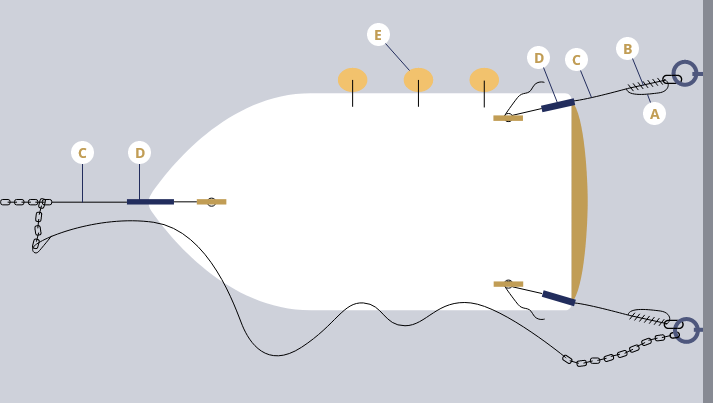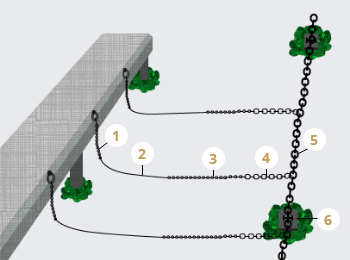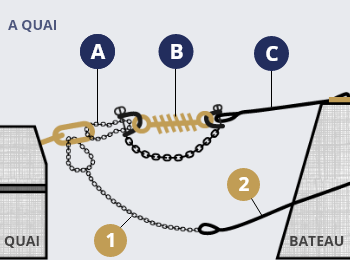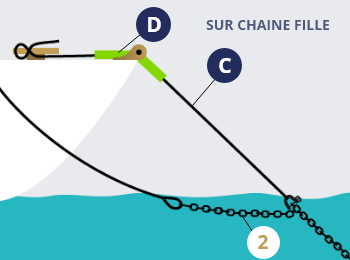Good mooring
practices
The weather is good. A rope holds the boat to the quay. The owner is gone longer than planned. The wind picks up and everything changes…
“Hello? Sir… your boat has broken a docking line. It’s nothing serious but the swimming ladder has been twisted and there’s a chip in the gel-coat on the hull…” The Harbour Master’s Office will replace the faulty rope (at the owner’s expense), but there may be damage to neighbouring boats, the boat itself or port facilities.
This kind of very frequent situation can be prevented! Each year, a natural event, more damaging than those encountered in the past occurs and brings damage in its wake! A properly functioning anchorage of the correct size is the best and least costly guarantee. This section will help pleasure boaters to prepare a hassle-free mooring. Can’t find what you’re looking for on this page? Don’t hesitate to get in touch.
What you need
to know
What is prohibited
Mooring without authorisation.
Handrails, bowsprits or raised gangways extending on to the quay.
Mooring on the lead-sealed mooring line which is not intended for such use.
Attaching equipment to the quays (access ladders, protective equipment, etc.) unless authorised by the Harbour Master’s Office.
What is mandatory
All boats, excluding inflatable dinghies, must be fitted with bow and stern mooring cleats, as well as fenders.
To be avoided
Lines set to the final length (especially if short) because they do not allow for slackening or gaining slack.
The use of polypropylene for mooring lines and fenders because of its low resistence to friction and weak knots.
Rigging a hawser directly on the mooring post for permanent mooring. With the tidal range, the roughness of the quays and effort, wear would occur rapidly.
Leaving a taught docking line in contact with an angular edge (anchor fluke, inverted fairlead, gangplank supporting structure, screw head, etc.) due to risks of wear and tear and breakage.
Fastening fenders to guardrails (they can fall on to the deck in strong wind).
What is advised
At berth, keep the docking line and small chain out of the water to prevent encrustation.
Shackle the front hawser so that, in the normal position, the docking line remains fully submerged.The mooring line will therefore be preserved longer from oxidation.
Fasten the fenders to the cleat, stanchion base or rubrail. Add one or two fenders to the transom for safety reasons.
When leaving, pull the front hawser with halfhitch knots on the nylon mooring line, it will be quicker to pull and will avoid handling of the mooring line on the way back.
Adjust your lines
Stern lines: same length > well-centred boat
Crossed docking lines: same length > at berth
Distancing: from 0.80 m to 2.50 m according to the size of the boat and the gangway used.
Taughtness of the sternline:
1. Small units: Ordinary mooring: For high tension on the stern lines, the boat comes almost right up to the quay, but without touching it. Extended mooring (wintering, prolonged absence of the owner, etc.): For very high tension on the sternlines, the boat does not come any closer than 0.50 m to the quay.
2. Units of more than 12 metres: The weight of the boat and the use of the gangway call for strong and constant tension of the docking lines in order to limit the boat’s movement. To this end, 22 metre and 30 metre berths are equipped with two “lazy lines”.
Once the boat is correctly adjusted to its berth, mark the docking lines with a touch of colour and add tips to the protection tubes.
berthing
1. At very low speed: An error of judgement at 1/4 knots is an incident which can be cushioned by a fender (well-placed). The same error at 3 knots becomes an accident.
2. In bad weather: Don’t hesitate to berth bow to the quay, to avoid any risky manoeuvres in reverse. If the berth is located upwind during momentarily very high winds, dock in a place which enables the manoeuvre to take place (e.g. along a quay) and when the wind dies down, return to your usual berth.
Mooring
equipment

A. galvanised chain
Length calculated to avoid chafing of the docking line on the quay and to provide safety backup in case the mooring damper breaks.
B. mooring damper
Indispensable for preserving hawsers and mooring cleats when the boat moves in wind and (or) with the swell.
C. 3 strand nylon
Chosen for its elasticity, strength and splice. Recommended lengths take into account the part required for the splice and the possibility to adjust the position of the boat as close as possible to the quay for embarkation or further away for extended mooring.
D. protection
Indispensable: an oversized yet non protected hawser can break during a night of bad weather.
E. FENDERS
Must be of a height and diameter suited to the shape of the plating. A well-protected boat is a guarantee of good neighbourliness.
Moorings at quay
and on "lazy lines"
Choose the berth size:
| Lashings | 1 to 2 state-of-the-art lashings, each made up of: | D. protection | E. number of fenders | |||
|---|---|---|---|---|---|---|
| 1 harp shackle galvan. diam. | C. 3-strand nylon | 1 stainless steel thimble | ||||
| diam. (mm) | length (m) | |||||
| Mesures | 10 | 10 | 3.50 | 12 | 0.50 m soft hose per hawser | 4 |
| Mesures | 12 | 4.00 | 14 | 0.50 m soft hose per hawser | 4 | |
| Mesures | 14 | 4.50 | 16 | 0.50 m soft hose per hawser | 6 | |
| Mesures | 14 | 5.00 | 18 | 0.50 m soft hose per hawser | 8 | |
| Mesures | 16 | 20 | 5.50 | 20 | 0.50 m soft hose per hawser | 8 |
| Mesures | 18 | 26 | 7,00 | 26 | 0.50 m soft hose per hawser | 12 |
| Mesures | 16 | 26 | 7.00 | 26 | 0.50 m soft hose per hawser | 12 |
| Mesures | 18 | 30 | 10.00 | 30 | 0.50 m soft hose per hawser | 14 |
For
anchorage
"PORT-FREJUS" provides pleasure boaters with:

at quay
Two anchor rings on the jetty or two bollards on the quays.

In the water
1. small chain connected to the anchor ring or to the bollard
2. Lead-sealed nylon mooring line
3. “Lazy chain”
4. Permanent chain 2 metres in length and with a diameter greater than that of the “lazy chain”. The permanent chain connects the rest to the main chain (5).
5. Main chain
6. Mooring post

pleasure boaters can make use of
A. B. C. D. 2 or 4 docking lines on quay
C. D. 1 or 2 docking lines on “lazy chain”
Nautical
Glossary
Bow line
A hawser which comes out of a front fairlead and which tends to drive forward, or which comes out of a rear fairlead and which tends to move astern, when turned.
Bollard
Mooring bitt.
Fag end
Piece of rope.
Anchor chain
A chain with an inside link length of 4 to 5.5 times the diameter of the chain. Shackels and ropes pass through with ease.
Fairlead
A guide ring for docking lines, with rounded parts to avoid rope chafing.
Reeve
1. Make a loop with a rope and put it over a post. 2. In French, "capeler" [reeve] a waterproof, simply means to wear it.
Thimble
Pear-shaped metal or plastic ring with a groove around its outer rim.
Harp shackle
Shackle with curved edges.
Tidal range
Differing sea levels due to the tide and atmospheric pressure.
Anchor ring
Docking ring.
Windward, leeward
A beach and a boat on the water. The wind blows from the beach towards the open sea; the boat travels leeward of the beach.




